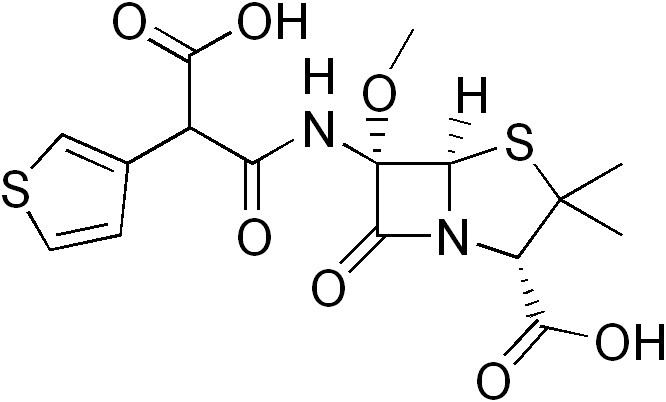ATC code J01CA17 (WHO) PubChem CID 171758 UNII 03QB156W6I | CAS Number 66148-78-5 ChemSpider 150149 Molar mass 414.453 g/mol | |
 | ||
AHFS/Drugs.com International Drug Names | ||
Temocillin how to pronounce it
Temocillin is a β-lactamase-resistant penicillin introduced by Beecham, marketed by Eumedica Pharmaceuticals as Negaban. It is used primarily for the treatment of multiple drug-resistant, Gram-negative bacteria. It is a carboxypenicillin.
Contents
- Temocillin how to pronounce it
- How to pronounce temocillin
- Pharmacology
- Dosage
- Adverse effects
- References
How to pronounce temocillin
Pharmacology
Temocillin is a β-lactamase-resistant penicillin. It is not active against Gram-positive bacteria or bacteria with altered penicillin-binding proteins.
It is normally active against Moraxella catarrhalis, Brucella abortus, Burkholderia cepacia, Citrobacter species, Escherichia coli, Haemophilus influenzae, Klebsiella pneumoniae, Pasteurella multocida, Proteus mirabilis, Salmonella typhimurium, and Yersinia enterocolitica. It is also active against some Enterobacter species, Morganella morganii, and Serratia species. Temocillin has no useful activity against Acinetobacter species or Pseudomonas aeruginosa.
Its primary use is against Enterobacteriaceae, and in particular against strains producing extended-spectrum β-lactamase or AmpC β-lactamase.
Dosage
The common dose is 2 g intravenously every 12 hours. Theoretical reasons exist for giving temocillin as a continuous intravenous infusion in severe disease: a single loading dose of 2 g is given intravenously followed by a 4-g infusion over 24 hours. Temocillin for intravenous injection is diluted in 20 ml of sterile water; it is diluted in less than 2.7 ml of sterile water when being prepared for intramuscular injection; the continuous infusion is diluted in 48 ml of sterile water for ease of administration (1 ml per half hour). To reduce pain, the intramuscular injection may be made up using sterile 1% lignocaine instead of sterile water.
Temocillin may be given to patients with impaired renal function. No adjustment needs to be made to the dose in mild to moderate renal impairment (creatinine clearance greater than 30 ml/min). Temocillin is cleared by haemodialysis, so in dialysis patients, the dose should be given after dialysis.
No oral preparation of temocillin is licensed.
Adverse effects
The undesirable effects of temocillin are those of any β-lactam antibiotic. In particular, it has been associated with angioedema and anaphylaxis in penicillin-allergic patients. Animal studies have not shown any induction of Clostridium difficile infection. As with any other penicillin, convulsions can occur if very high doses are given.
